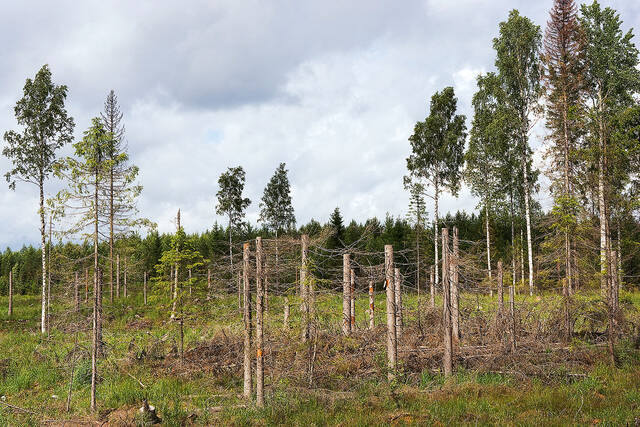Tekopökkelöiden tekeminen
- Inte tillgänglig på svenska
Sanasto
- Lahopuujatkumo
Lahopuujatkumolla tarkoitetaan tilannetta, jossa alueella on samanaikaisesti eri lahoasteen lahopuita ja sinne syntyy tuoretta lahopuuta. Hyvässä lahopuujatkumossa kohteella olevasta lahopuusta noin kolmasosa on pitkälle lahonneita, kolmasosa keskilahoja ja kolmasosa vastikään kuollutta puuta.
Lahopuujatkumo voi esiintyä kohteella luontaisesti. Sitä voidaan myös ylläpitää jättämällä eläviä säästöpuita ja tekemällä tekopökkelöitä.
Kirjallisuus
- Jonsell, M., Nitterus, K. & Stighäll, K. 2004: Saproxylic beetles in natural and manmade deciduous high stumps retained for conservation. Biol. Conserv. 118: 163-173.
https://doi.org/10.1016/j.biocon.2003.08.017(ulkoinen linkki) - Lindhe, A. & Lindelöw, Å. 2004: Cut high stumps of spruce, birch, aspen and oak as breeding substrates for saproxylic beetles. For. Ecol. Manage. 203: 1-20.
https://doi.org/10.1016/j.foreco.2004.07.047(ulkoinen linkki) - Lindhe, A., Lindelöw, Å. & Åsenblad, N. 2005: Saproxylic beetles in standing dead wood density in relation to substrate sun-exposure and diameter. Biodivers. Conserv. 14: 3033-3053.
http://dx.doi.org/10.1007/s10531-004-0314-y(ulkoinen linkki) - Lindbladh, M. & Abrahamsson, M. 2008: Beetle diversity in high-stumps from Norway spruce thinnings. Scand. J. For. Res. 23: 339-347.
https://doi.org/10.1080/02827580802282762(ulkoinen linkki) - Hallinger, M., Kärvemo, S. & Ranius, T. 2018: Does it pay to concentrate conservation efforts for dead-wood dependent insects close to existing reserves: a test on conservation planning in Sweden. Insect Conservation and Diversity 11: 317-329.
https://doi.org/10.1111/icad.12279(ulkoinen linkki) - Björklund, H., Purhonen, J., Paukkunen, J., Pitkänen, S., Stigell, E. & Sutinen, S. 2023: Tekopökkelöiden tekeminen talousmetsissä: Opas metsänomistajille ja metsäammattilaisille. Luonnontieteellinen keskusmuseo LUOMUS, Helsingin yliopisto.
https://metsonpolku.fi/documents/115183005/127649121/Tekopoly-ohje-verkkoversio_final.pdf(ulkoinen linkki) - Toivanen, T. & Kotiaho, J.S. 2010: The preferences of saproxylic beetle species for different dead wood types created in forest restoration treatments. Can. J. For. Res. 40: 445-464.
https://doi.org/10.1139/X09-205(ulkoinen linkki) - Hedgren, P. O. 2007. Early arriving saproxylic beetles (Coleoptera) and parasitoids (Hymenoptera) in low and high stumps of Norway spruce. Forest Ecology and Management, 241, 155-161.
- Melin, M., Laakso, T., Kärkkäinen, L., Packalen, T. & Viiri, H. 2021. Kirjanpainajatuhot, suojelualueet ja aluevaraukset – lainsäädäntö ja mahdolliset ongelmakohdat tuhojen levitessä. Metsätieteen aikakauskirja 2021-10522. Tieteen tori. 9 s.
https://doi.org/10.14214/ma.10522(ulkoinen linkki) - Bradshaw, C.J.A. & Warkentin, I.G. 2015: Global estimates of boreal forest carbon stocks and flux. Global and Planetary Change 128: 24-30.
- Krankina, O.N. & Harmon, M.E. Dynamics of the dead wood carbon pool in northwestern Russian boreal forests. Water Air Soil Pollution. (1995) 82: 227.
https://doi-org.libproxy.helsinki.fi/10.1007/BF01182836(ulkoinen linkki) - Gustafsson, L. ym. 2012. Retention forestry to maintain multifunctional forests: A world perspective. BioScience, 62: 633–645.
https://doi.org/10.1525/bio.2012.62.7.6(ulkoinen linkki) - Lehtonen, A. et al. 2021. Maankäyttösektorin ilmastotoimenpiteet: Arvio päästövähennysmahdollisuuksista. Luonnonvara- ja biotalouden tutkimus 65/2021. Luonnonvarakeskus. Helsinki. 122 s.
- Mäkinen, H., Hynynen, J., Siitonen, J., Sievänen, R. 2006. Predicting the decomposition of scots pine, Norway spruce, and birch stems in Finland. Ecological Applications 16(5): 1865–1879.
- Holeksa, J., Zielonka, T., & Żywiec, M. 2008. Modeling the decay of coarse woody debris in a subalpine Norway spruce forest of the West Carpathians, Poland. Canadian Journal of Forest Research, 38(3), 415-428.
- Niemelä T, Wallenius T, Kotiranta H. 2002. The kelo tree, a vanishing substrate of specified wood-inhabiting fungi. Pol Bot J 47(2):91–101
- Pukkala, T., 2018. Carbon forestry is surprising. Forest Ecosystems 5, 11
https://forestecosyst.springeropen.com/articles/10.1186/s40663-018-0131-5(ulkoinen linkki) - Valkonen, S., Ruuska, J. & Siipilehto, J. 2001: Mäntysäästöpuut männyntaimikoissa – aukkoisuutta, kasvutappioita vai laatua? Metsätieteen aikakauskirja 1/2001: 55-59.
- Valkonen, S., Sirén, M. & Piri, T. 2010. Poiminta- ja pienaukkohakkuut – vaihtoehtoja avohakkuulle. Metsäkustannus Oy.
- Hosionaho, M. 2012: Säästöpuuryhmien vaikutus luontaisen taimiaineksen syntyyn uudistusaloilla. Pro gradu, Helsingin yliopisto.
https://www.theseus.fi/handle/10024/39585(ulkoinen linkki) - Palik M. 2003: Spatial distribution of overstorey retention influences resources and growth of longleaf pine seedlings. Ecol. Appl. 13: 674-686.
- Sterkenburg ym. 2019. The significance of retention trees for survival of ectomycorrhizal fungi in clear-cut Scots pine forests. J. Appl. Ecol. 56: 1367– 1378.
https://doi.org/10.1111/1365-2664.13363(ulkoinen linkki) - Korkama ym. 2006. Ectomycorrhizal community structure varies among Norway spruce (Picea abies) clones. New Phytologist, 171: 815–824.
https://doi.org/10.1111/j.1469-8137.2006.01786.x(ulkoinen linkki) - Outerbridge, R.A. & Trofymow, J.A. 2009: Forest management and maintenance of ectomycorrhizae: A case study of green tree retention in south-coastal British Columbia. J. Ecosyst. Manag. 10: 6.
- Stokland, J. N., Siitonen, J. & Jonsson, B. G. 2012. Biodiversity in dead wood. Cambridge, UK. Cambridge University Press. 509 s.
- Seibold ym. 2021: The contribution of insects to global forest deadwood decomposition. Nature.
https://doi.org/10.1038/s41586-021-03740-8(ulkoinen linkki)
